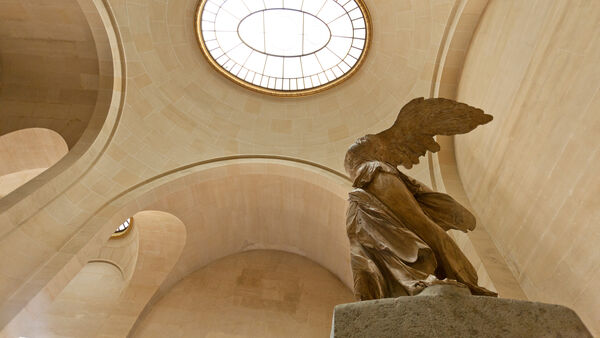A Look at the ‘Victory of Samothrace’...and How Turkey Gave France the Finger
By Rick Steves, Gene Openshaw, and Steve Smith
One of the Louvre Museum's most thrillingly-displayed treasures is the Winged Victory of Samothrace. This woman with wings, poised on the prow of a ship, once stood on an island hilltop to commemorate a naval victory. Her clothes are windblown and sea-sprayed, clinging close enough to her body to win a wet T-shirt contest. (When you visit, look at the detail in the folds of her dress around the navel, curving down to her hips.) Originally, her right arm was stretched high, celebrating the victory like a Super Bowl champion, waving a "we're number one" finger.
This is the Venus de Milo gone Hellenistic, from the time after the culture of Athens was spread around the Mediterranean by Alexander the Great (c. 325 BC). As Victory strides forward, the wind blows her and her wings back. Her feet are firmly on the ground, but her wings (and missing arms) stretch upward. She is a pillar of vertical strength, while the clothes curve and whip around her. These opposing forces create a feeling of great energy, making her the lightest two-ton piece of rock in captivity.
The earlier Golden Age Greeks might have considered this statue ugly. Her rippling excitement is a far cry from the dainty Parthenon maidens and the soft-focus beauty of Venus. And the statue's off-balance pose, like an unfinished melody, leaves you hanging. But Hellenistic Greeks loved these cliff-hanging scenes of real-life humans struggling to make their mark.
In the glass case nearby is Victory's open right hand with an outstretched finger, found in 1950, a century after the statue itself was unearthed. When the French discovered this was in Turkey, they negotiated with the Turkish government for the rights to it. Considering all the other ancient treasures the French had looted from Turkey in the past, the Turks thought it only appropriate to give France the finger.
With more than 30,000 works of art, the Louvre is a full inventory of Western civilization. A visit here lets you traverse the centuries — and gives you a chance to see how each generation defined beauty differently, to gain insight into long-ago civilizations by admiring what they found beautiful.
Steve Smith and Gene Openshaw are the co-authors of the Rick Steves Paris guidebook.


